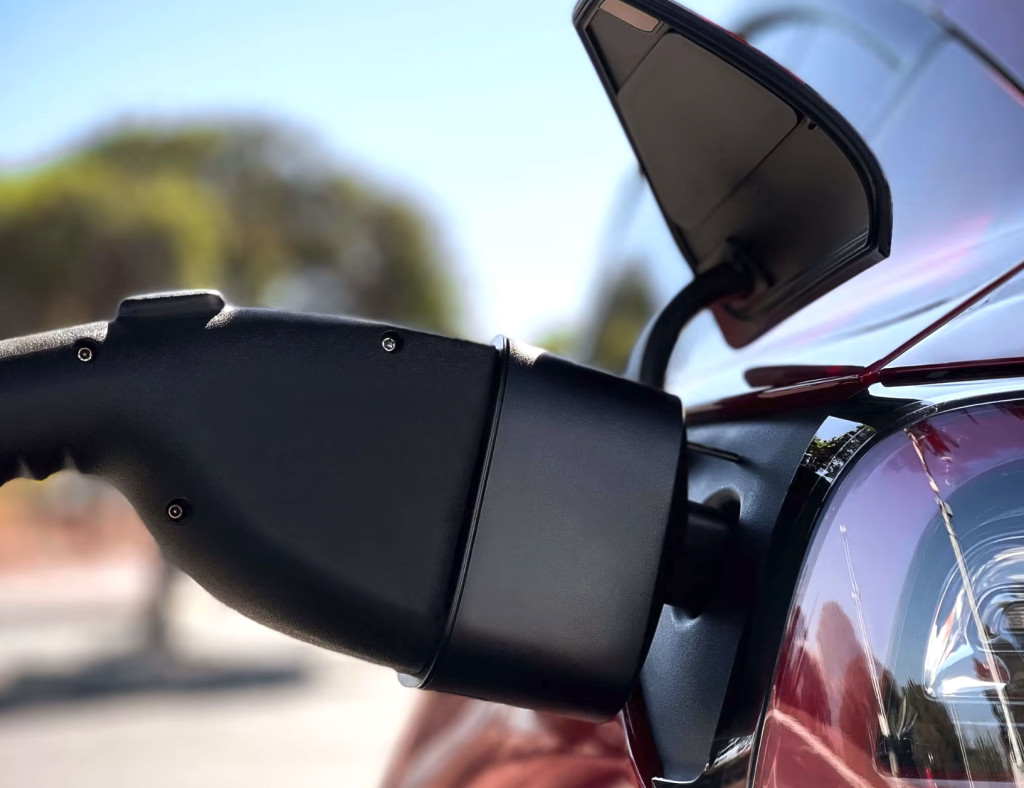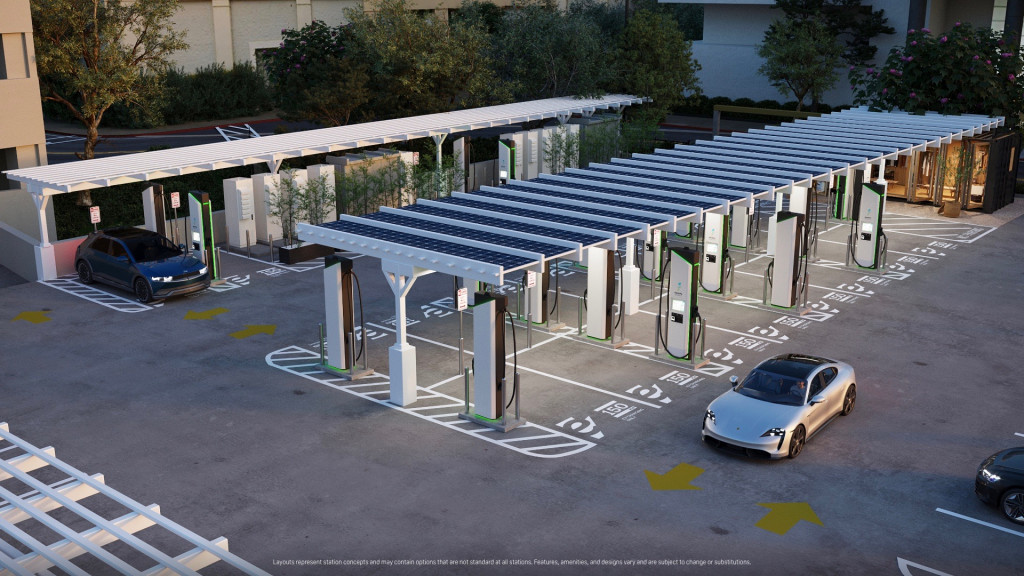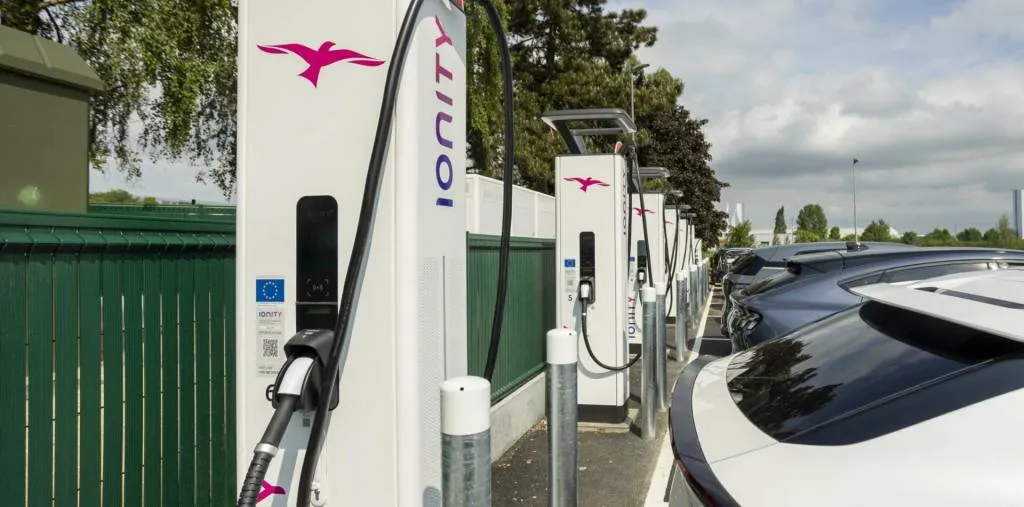Road-trip charging of electric cars doesn’t have to be so hard.
That’s what Tesla has essentially proven with its Supercharger network, but as of yet, no other network has come close to providing the same level of reliability or uptime, or a consistent experience.
That, and the mammoth charging infrastructure buildout necessary to support EV sales targets, appears to be the impetus behind a yet-unnamed charging network venture announced Wednesday morning that is backed by seven major global automakers: BMW Group, General Motors, Honda, Hyundai, Kia, Mercedes-Benz, and Stellantis.
It’s aiming to install at least 30,000 high-powered charge points in urban and highway locations “to ensure customers can charge whenever and wherever they need,” and will have “a focus on delivering an elevated customer experience,” according to an initial release, with reliability and appealing locations offering various amenities among the top priorities.
Stations on this new network will be accessible to “all battery-powered electric vehicles from any automaker using Combined Charging System (CCS) or North American Charging Standard (NACS),” the venture explained, which will cover the vast majority of EVs on the road—all except for the Nissan Leaf and a few others on the CHAdeMO standard.

GM EVs get Tesla Supercharger access in 2024
350-kw, 800-volt, and NACS V4 electric car charging? Yes, yes, and yes
The network aims to offer 350-kw connectors as a starting point in its experience—a detail that may truly help satisfy drivers with road-trip charging needs, if it can coordinate all the software and hardware to function smoothly.
“We want EV customers to significantly reduce their charging times from the beginning of the joint venture,” said the seven founding members, in a joint statement to Green Car Reports. “For this, the joint venture aims for having the best charging power available on the market and technological state-of-the-art charging at all times.”
The companies wouldn’t yet say exactly whether that means Tesla NACS V4 compatibility—a necessary piece for charging some 800-volt vehicles at peak rate. But the answer’s essentially there, as they emphasized to GCR that the venture “aims for having the best charging power available on the market and technological state-of-the-art charging at all times.”

Tesla CCS1 adapter charging
Pricing and access details haven’t yet been worked out. But it emphasized “a seamless, vehicle-integrated, best-in-class charging experience,” with the entire network powered by renewable energy. The interface will include reservations and intelligent route planning, and support for Plug & Charge technology from the start.
And if that's not enough of a hint, GM and Mercedes-Benz are among the automakers that have already announced plans to shift to the Tesla NACS port for charging starting in 2025—and support for V4 becomes an essential piece for GM's big electric trucks.

Electrify America upscale charging concepts
Putting it in perspective with Tesla Supercharger, Electrify America
To put this network’s plan for 30,000 high-power connectors in perspective: The Tesla Supercharger network now offers nearly 20,400 DC fast-charging ports (at nearly 1,900 locations), according to the U.S. Department of Energy. The vast majority of those Tesla Supercharging connectors are capable of charging compatible vehicles at up to 250 kw, with a unified interface and charging experience across the whole network.
VW’s Electrify America network offers nearly 3,600 DC fast-charging ports at about 800 charging locations. On that network, charge power starts at 150 kw and 350-kw connectors are still relatively rare.
As the U.S. National Renewable Energy Laboratory (NREL) estimated in a study released in June, the 30 million to 42 million EVs on U.S. roads by 2030 will require 182,000 publicly accessible DC fast-charging ports.
In some ways, what this network is doing may be essentially learning from what worked in Europe. BMW, Mercedes, Ford, VW, and Audi launched the Ionity fast-charging network there in 2017. It eventually gained more stakeholders, including Hyundai and Kia, and in the course of a few years it helped build Europe into a stronger EV market than the U.S.
In the U.S., Electrify America's origin story is quite different, as it was created with $2 billion from the Volkswagen Group as part of the automaker's diesel-emissions-cheating settlement with the federal government. EA has tried to expand beyond its original plan with investment from other automakers, but the tech supplier Siemens remains its sole other investor.
That said, in a statement provided to Green Car Reports, Electrify America painted the formation of the competing network as a net positive: ”The demand for public charging stations in North America will continue to grow as EV ownership becomes mainstream. This announcement further validates our network business model of reaching consumers in urban and highway areas. We believe the momentum in meeting the need for EV charging infrastructure is a positive development for consumers.”

Ionity charging in France
Charging network business details: All TBD
Virtually all the business aspects of this new joint venture are yet unannounced—including the size of the expected total investment and the amount expected of each stakeholder, which will have equal rights. The companies say that the joint venture will include the development of this network, but it might not be limited to just that.
The venture does say that it’s expecting “to meet or exceed the spirit and requirements of the U.S. National Electric Vehicle Infrastructure (NEVI) program"—a program that is being tightened with more requirements for reporting of uptime and reliability. That will make it one of many companies vying for federal funds at the state level, and the venture told Green Car Reports that it will “evaluate options to work with local governments and available public funding to enable the set-up of the network.”
Ultimately, it may expand with public or private funds, and it’s open to investment from other automakers—like Ford, Nissan, or Toyota, all of which aren’t involved at this point—or from affiliated tech companies or outside the auto industry. All three declined to confirm to Green Car Reports that they had been involved in the plan or have interest in joining.
The first stations in this network are due to open in the summer of 2024, with Canada due to be added at a later stage. Both GM and Mercedes-Benz, which planned significant fast-charging network buildouts in North America, say that their existing plans are unaffected.













